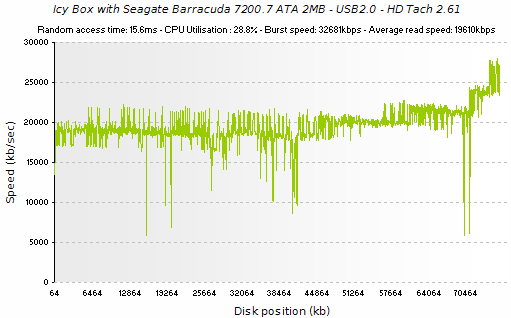Performance
Performance, as far as an external disk enclosure is concerned, is all about minimising the damage done by forcing the native interface to run over USB2.0 or similar. With USB2.0 topping out at 56MB/sec, you'd think it's more than enough for any decent 7200rpm hard disk. Factor in protocol conversion overheads, other devices sharing the bus (as far as USB2.0 is concerned at least) and the basic ability of the chip doing the conversion, and there's plenty to bottleneck things.I therefore wasn't too surprised to see the Icy Box, packed with a very capable Seagate 7200.7 ATA 80GB disks, put up the following HDTach 2.6 numbers.

Bursting at ~32MB/sec and sustaining under 20MB/sec isn't the stuff of champions, but it's passable performance from an external disk enclosure. Analysis with a WD800BB (Western Digital's equivalent to the 7200.7, with 2MB and 80GB) shows similar results.
Given the limitation that the interface and conversion ASIC puts on performance, you'd be fine with disks whos platters rotate slower. Which leads nicely on to noise and temperature performance.
Noise and Temperatures
The Icy Box documentation makes a big deal about it being quiet and cool, the design of the unit keeping disk-generated noise to a minimum and the entire unit acting like a big heatsink for the hard disk. In practice, it definitely seems to be the case.While Seagate's 7200.7 ATA disk and Western Digital's WD800BB disk aren't the noisiest drives you'll ever come across, inside the Icy Box you'd be hard pressed to tell they were in and working. During the performance tests, while running HDTach and some simple disk copying, you can see the blue light on the Icy Box flicker while there's drive activity, but you can't actually hear that activity at all. Good stuff.
Temperature wise, the Icy Box doesn't disappoint either. Copying 20GB of data to the 7200.7 inside the Icy Box gave rise to a lukewarm 32°C top panel temperature, as measured by my digital thermometer. Ambient room temperature was a chilly 15°C at the time, to give you an idea of the temperature delta.









